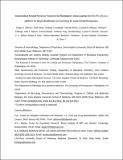| dc.contributor.author | Akimov, Sergey S | |
| dc.contributor.author | Jiang, Mali | |
| dc.contributor.author | Kedaigle, Amanda Joy | |
| dc.contributor.author | Arbez, Nicolas | |
| dc.contributor.author | Marque, Leonard O | |
| dc.contributor.author | Eddings, Chelsy R | |
| dc.contributor.author | Ranum, Paul T | |
| dc.contributor.author | Whelan, Emma | |
| dc.contributor.author | Tang, Anthony | |
| dc.contributor.author | Wang, Ronald | |
| dc.contributor.author | DeVine, Lauren R | |
| dc.contributor.author | Talbot, Conover C | |
| dc.contributor.author | Cole, Robert N | |
| dc.contributor.author | Ratovitski, Tamara | |
| dc.contributor.author | Davidson, Beverly L | |
| dc.contributor.author | Fraenkel, Ernest | |
| dc.contributor.author | Ross, Christopher A | |
| dc.date.accessioned | 2021-09-16T14:38:32Z | |
| dc.date.available | 2021-09-16T14:38:32Z | |
| dc.date.issued | 2021-07 | |
| dc.date.submitted | 2021-07 | |
| dc.identifier.issn | 0964-6906 | |
| dc.identifier.issn | 1460-2083 | |
| dc.identifier.uri | https://hdl.handle.net/1721.1/131267 | |
| dc.description.abstract | We have previously established Induced Pluripotent Stem cell (iPSC) models of Huntington’s Disease (HD), demonstrating CAG-repeat-expansion-dependent cell biological changes and toxicity. However, the current differentiation protocols are cumbersome and time consuming, making preparation of large quantities of cells for biochemical or screening assays difficult. Here, we report the generation of Immortalized Striatal Precursor Neurons (ISPNs) with normal (33) and expanded (180) CAG repeats from HD iPSCs, differentiated to a phenotype resembling Medium Spiny Neurons (MSN), as a proof of principle for a more tractable patient-derived cell model. For immortalization we used co-expression of the enzymatic component of telomerase hTERT and conditional expression of c-Myc. ISPNs can be propagated as stable adherent cell lines, and rapidly differentiated into highly homogeneous MSN-like cultures within two weeks, as demonstrated by immunocytochemical criteria. Differentiated ISPNs recapitulate major HD-related phenotypes of the parental iPSC model, including BDNF-withdrawal-induced cell death that can be rescued by small molecules previously validated in the parental iPSC model. Proteome and RNA-seq analyses demonstrate separation of HD versus control samples by Principal Component Analysis. We identified several networks, pathways, and upstream regulators, also found altered in HD iPSCs, other HD models, and HD patient samples. HD ISPN lines may be useful for studying HD-related cellular pathogenesis, and for use as a platform for HD target identification and screening experimental therapeutics. The described approach for generation of ISPNs from differentiated patient-derived iPSCs could be applied to a larger allelic series of HD cell lines, and to comparable modeling of other genetic disorders. | en_US |
| dc.language.iso | en | |
| dc.publisher | Oxford University Press (OUP) | en_US |
| dc.relation.isversionof | http://dx.doi.org/10.1093/hmg/ddab200 | en_US |
| dc.rights | Creative Commons Attribution-Noncommercial-Share Alike | en_US |
| dc.rights.uri | http://creativecommons.org/licenses/by-nc-sa/4.0/ | en_US |
| dc.source | Prof. Fraenkel | en_US |
| dc.title | Immortalized striatal precursor neurons from Huntington’s disease patient-derived iPS cells as a platform for target identification and screening for experimental therapeutics | en_US |
| dc.type | Article | en_US |
| dc.identifier.citation | Akimov, Sergey S. et al. "Immortalized striatal precursor neurons from Huntington’s disease patient-derived iPS cells as a platform for target identification and screening for experimental therapeutics." Human Molecular Genetics (July 2021): ddab200. | en_US |
| dc.contributor.department | Massachusetts Institute of Technology. Computational and Systems Biology Program | en_US |
| dc.contributor.department | Massachusetts Institute of Technology. Department of Biological Engineering | en_US |
| dc.relation.journal | Human Molecular Genetics | en_US |
| dc.eprint.version | Final published version | en_US |
| dc.type.uri | http://purl.org/eprint/type/JournalArticle | en_US |
| eprint.status | http://purl.org/eprint/status/PeerReviewed | en_US |
| dc.date.updated | 2021-09-15T15:06:09Z | |
| dspace.orderedauthors | Akimov, SS; Jiang, M; Kedaigle, AJ; Arbez, N; Marque, LO; Eddings, CR; Ranum, PT; Whelan, E; Tang, A; Wang, R; DeVine, LR; Talbot, CC; Cole, RN; Ratovitski, T; Davidson, BL; Fraenkel, E; Ross, CA | en_US |
| dspace.date.submission | 2021-09-15T15:06:11Z | |
| mit.license | OPEN_ACCESS_POLICY | |
| mit.metadata.status | Complete | en_US |
